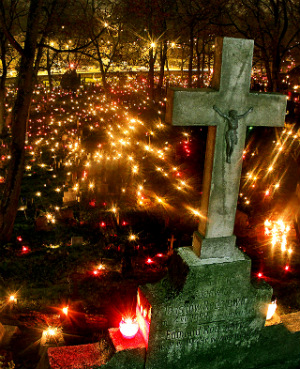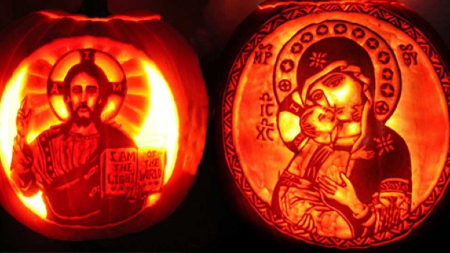We ask you, humbly: don't scroll away.
Hi readers, it seems you use Catholic Online a lot; that's great! It's a little awkward to ask, but we need your help. If you have already donated, we sincerely thank you. We're not salespeople, but we depend on donations averaging $14.76 and fewer than 1% of readers give. If you donate just $5.00, the price of your coffee, Catholic Online School could keep thriving. Thank you.Help Now >
Foxe's Book of Martyrs
FREE Catholic Classes
John Foxe was born at Boston in Lincolnshire, England, in 1516, and was educated at Magdalen School and College, Oxford. He joined the more extreme Reformers early in life and under Edward VI acted as tutor to the children of the recently beheaded Earl Of Surrey. In Mary's reign he fled to Germany and joined the exiles at Frankfort. In the controversy which arose there he took sides with Knox and the extremists and after the break up of the Frankfort colony he went to Basle where poverty compelled him to take service with the Protestant printer Oporinus. In 1539 he returned to England and entered the ministry, he was helped by his old pupil the Duke of Norfolk and was mainly occupied with his martyrology. He still belonged to the extremists and objected to the surplice. His opinions interfered with his prospects, but he was not an ambitious man. Though violent and dishonest in controversy, he was personally of a kind and charitable temper. Besides his "Acts and Monuments" he published a number of sermons, translations, and controversial attacks on Catholicism. He died in 1587.
Even before leaving England in 1554 Foxe had begun the story of the persecutions of the Reformers. The result was the publication of a little Latin work dealing mainly with Wyclifism. While at Basle he was supplied by Grindal with reports of the persecution in England and in 1559 he published a large Latin folio of 740 pages which began with Wyclif and ended with Cranmer. After his return to England he began to translate this book and to add to it the results of fresh information. The "Acts and Monuments" were finally published in 1563 but came almost immediately to he known as the "Book of Martyrs ". The critism which the work called forth led to the publication of a "corrected" edition in 1570. Two more (1576 and 1583) came out during his life and five (1596, 1610, 1632, 1641, 1684) within the next hundred years. There have been two modern editions, both unsatisfactory; they are in eight volumes and were published in 1837-41 and 1877. The size may be gathered from the fact that in the edition of 1684 it consists of three folio volumes of 895, 682, and 863 pages respectively. Each page has two columns and over eighty lines. The first volume besides introductory matter contains the story of early Christian persecutions, a sketch of medieval church history and an account of the Wyclifite movement in England and on the continent. The second volume deals with the reigns Henry VII and Edward VI and the third with that of Mary. A large number of official documents such as injunctions, articles of accusation, letters, etc., have been included. The book is illustrated throughout by woodcuts, some of them symbolizing the triumph of the Reformation, most of them depicting the sufferings of the martyrs.
The Convocation of the English Church ordered in 1571 that copies of the "Book of Martyrs " should be kept for public inspection in all cathedrals and in the houses of church dignitaries. The book was also exposed in many parish churches. The passionate intensity of the style, the vivid and picturesque dialogues made it very popular among Puritan and Low Church families down to the nineteenth century. Even in the fantastically partisan church history of the earlier portion of the book, with its grotesque stories of popes and monks and its motley succession of witnesses to the truth (including the Albigenses, Grosseteste, Dante, and Savonarola ) was accepted among simple folk and must have contributed much to anti-Catholic prejudices in England. When Foxe treats of his own times his work is of greater value as it contains many documents and is but largely based on the reports of eyewitnesses; but he sometimes dishonesty mutilates his documents and is quite untrustworthy in his treatment of evidence. He was criticized in his own day by Catholics such as Harpsfield and Father Parsons and by practically all serious eccesiastical historians.
Join the Movement
When you sign up below, you don't just join an email list - you're joining an entire movement for Free world class Catholic education.
-

-
Mysteries of the Rosary
-
St. Faustina Kowalska
-
Litany of the Blessed Virgin Mary
-
Saint of the Day for Wednesday, Oct 4th, 2023
-
Popular Saints
-
St. Francis of Assisi
-
Bible
-
Female / Women Saints
-
7 Morning Prayers you need to get your day started with God
-
Litany of the Blessed Virgin Mary
All Saints' Day, Halloween and All Souls' Day: What's the difference?
-

Should Christians Celebrate Halloween?
-

Since when did Halloween become a Christian holiday?
-
ADORABLE: A Little Boy's Heartfelt Lunchtime Prayer
-
Scientists Decode 3,000-Year-Old Babylonian Tablet, Revealing Potential Location of Noah's Ark
Daily Catholic
 Daily Readings for Friday, November 01, 2024
Daily Readings for Friday, November 01, 2024 St. Valentine Berrio-Ochoa: Saint of the Day for Friday, November 01, 2024
St. Valentine Berrio-Ochoa: Saint of the Day for Friday, November 01, 2024 Litany of the Saints: Prayer of the Day for Friday, November 01, 2024
Litany of the Saints: Prayer of the Day for Friday, November 01, 2024- Daily Readings for Thursday, October 31, 2024
- St. Wolfgang: Saint of the Day for Thursday, October 31, 2024
- Memorare: Prayer of the Day for Thursday, October 31, 2024
![]()
Copyright 2024 Catholic Online. All materials contained on this site, whether written, audible or visual are the exclusive property of Catholic Online and are protected under U.S. and International copyright laws, © Copyright 2024 Catholic Online. Any unauthorized use, without prior written consent of Catholic Online is strictly forbidden and prohibited.
Catholic Online is a Project of Your Catholic Voice Foundation, a Not-for-Profit Corporation. Your Catholic Voice Foundation has been granted a recognition of tax exemption under Section 501(c)(3) of the Internal Revenue Code. Federal Tax Identification Number: 81-0596847. Your gift is tax-deductible as allowed by law.






 Daily Readings for Friday, November 01, 2024
Daily Readings for Friday, November 01, 2024 St. Valentine Berrio-Ochoa: Saint of the Day for Friday, November 01, 2024
St. Valentine Berrio-Ochoa: Saint of the Day for Friday, November 01, 2024 Litany of the Saints: Prayer of the Day for Friday, November 01, 2024
Litany of the Saints: Prayer of the Day for Friday, November 01, 2024


